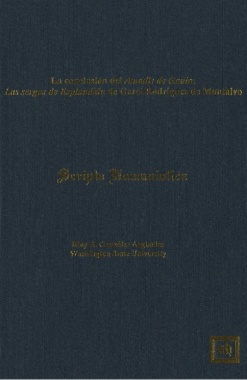The Amadís de Gaula, the most important of all Spanish chivalric texts, has been known to readers through the recasting of Garci Rodríguez de Montalvo, who also penned his own (for the most part) conclusion to the work, the Sergas de Esplandián. While the intentions of the original Amadís may have been quite different from those of Montalvo, he adopted and adapted it as part of an overall plan. In this study González takes side with those scholars who have argued that both works must be read as part of the same roman fleuve in order to ascertain what this plan was. The author probes deeply into Montalvo's efforts to sustain the interest of his reader while adhering to the narrative model of the Amadís. González's analysis of the Sergas leads him to a thorough examination of its literary techniques, plot construction, the moralizing interspersed throughout the text, and the functions of main and secondary characters, including the auctor, Montalvo's fictional alter-ego.
- Cover
- Tabla de contenidos
- Dedicatoria y Reconocimiento
- CAPÍTULO 1: LA CRÍTICA Y LAS SERGAS
- 1.1 Garci Rodríguez de Montalvo
- 1.2 Las Sergas de Esplandián: ¿roman, novela, libro de caballerías?
- 1.3 Las Sergas y la critica: de Gayangos a W.T. Little
- 1.4 La critica más reciente
- 1.5 Enfoque de este estudio
- CAPÍTULO 2: ESPLANDIAN Y LEONORINA EN LA TRAMA DEL AMADIS
- 2.1 El nacimiento y la niñez del héroe
- 2.2 Leonorina en el Amadís
- CAPÍTULO 3: LA SECUENCIA PRINCIPAL EN LA TRAMA DE LAS SERGAS
- 3.1 Los modelos del Amadís/Sergas
- 3.2 Topología de las Sergas: evolución del espacio mítico
- 3.3 El modelo estructural del Amadis y las Sergas
- 3.4 La articulación de la trama: el código proairético
- 3.5 La secuencia proairética principal en las Sergas
- CAPÍTULO 4: LOS PERSONAJES PRINCIPALES
- 4.1 El código sémico
- 4.2 Leonorina
- 4.3 Esplandián
- CAPÍTULO 5: EL CÓDIGO HERMENÉUTICO: URGANDA Y SUS PROFECÍAS
- 5.1 El código hermenéut
- 5.2 Las profecías en el Amadís y las Serga
- 5.3 La problemática de la predicción en las Sergas
- 5.4 Tormentas
- 5.5 Batalla
- 5.6 Urganda la Desconocida en el Amadís
- 5.7 Urganda en las Sergas
- CAPÍTULO 6: LAS VOCES NARRATIVAS
- 6.1 La voz del refundidor en el Prólogo del Amadís
- 6.2 Dos voces: refundidor y narrado
- 6.3 Las fórmulas narrativas en el Amadís
- 6.4 Los "enxemplos y doctrinas" en el Amadís
- 6.5 Glosas y comentarios integrados
- 6.6 Los temas de la moralización
- 6.7 Las fórmulas narrativas en las Sergas
- 6.8 El "auctor" en las Sergas
- 6.9 La moralización en las Sergas
- CAPÍTULO 7: LAS SECUENCIAS PROAIRÉTICAS SECUNDARIAS
- 7.1 División de las secuencias
- 7.2 Caballeros noveles y doncellas desnudas
- 7.3 Los caballeros y damas de antaño
- 7.4 Carmela
- 7.5 Melía
- 7.6 Armato, Alforax, Heliaxa, Radiaro
- 7.7 El corsario Tartario, Frandaló, Calafia
- CAPÍTULO 8: CONCLUSIÓN
- 8.1 La espacialidad en las Sergas
- 8.2 El sentido de las Sergas
- BIBLIOGRAFÍA

